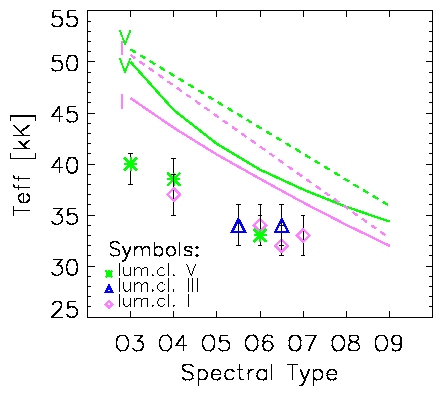
Information from
Luciana Bianchi and Miriam Garcia, JHU;
Presentation courtesy of William Blair, JHU.
The hottest, most massive stars are intriguing to astronomers. Although they constitute a small fraction of the total number of stars, these heavy-weights command attention due to their great luminosity (or energy output), and thus the impact they can have on their surroundings. The luminosity of a star increases rapidly with temperature, such that a star with a surface temperature twice that of another star does not have just twice the luminosity, but rather 16 times the luminosity (2 to the 4th power). These exotic stellar beacons pay a price for their extravagance, however, using up their available nuclear fuel in just 10's of millions of years (a factor of 1000 times shorter than our sun, for instance). These stars are the "SUVs" of the stellar world; they start with a larger gas tank, but they run it dry while the Geo Metros (like the sun) keep on going!
The FUSE satellite has spent a lot of time observing hot stars, because such stars put out much of their observed energy in the ultraviolet spectral range. The new data provided by both FUSE and the Hubble Space Telescope have spurred on a revitalized effort to understand these important stars. Sophisticated computer models of these stars and their atmospheres and winds are being fit to these new spectral observations, shedding new light on the characteristics of these stellar behemoths. One of the startling results coming out of these analyses is that these hot stars aren't as hot as we thought they were!

Caption: The revised temperature scale for Milky Way hot (O) stars. The vertical scale is surface temperature in thousands of degrees on the Kelvin scale (kK). The horizontal scale shows the spectral type of various stars, as judeged from their optical spectra. The lines indicate several previous calibrations of the hot star temperature scale, while the symbols with error bars below the lines indicate the lower temperatures being found from careful modeling of FUSE and HST ultraviolet spectra of these stars. (See HERE for more information.) Different colors (line-style/symbols) indicate different luminosity classes of stars, with "V" indicating main sequence stars, "III" indicating giants, and "I" indicating supergiant stars.

The temperatures of the hottest stars matter for lots of reasons. First, it matters to the stars themselves and to their evolution. If these stars are cooler than we thought, they are less luminous than we thought, and also less massive than we thought. At the hottest end, the 20 percent lower temperature means these stars are less luminous by a factor of 2 than previously calculated. That makes a big difference!
Secondly, it matters to the region of space surrounding such stars. Stars form out of clouds of gas and dust. As massive stars form, their energy interacts with the remaining gas and dust, ionizing the gas and causing it to glow, as in the HST picture at left of a star forming region in a nearby galaxy (called NGC 6822). This process basically regulates the star formation. When enough massive stars have formed to dissipate the surrounding gas and dust, further star formation in that region is terminated. Using incorrect temperatures for the hottest stars causes all of our previous calculations of this process and how it occurs to be incorrect by a substantial factor. It takes more massive stars to form before the remaining gas can be dissipated.
Thirdly, on an even grander scale, it matters for how galaxies formed and evolved over the history of the universe! Star formation is such a basic process that anything incorrect in our analysis of this process has huge ramifications for understanding what has gone before.
Photo/graphic credits: Courtesy Luciana Bianchi and Miriam Garcia.
For more information visit these sites:
Dr. Luciana Bianchi's research summaries page.
NASA News release from June 2002 AAS mmeting,
as presented by Spaceflight Now News site, highlighting related work by a group at NASA GSFC.